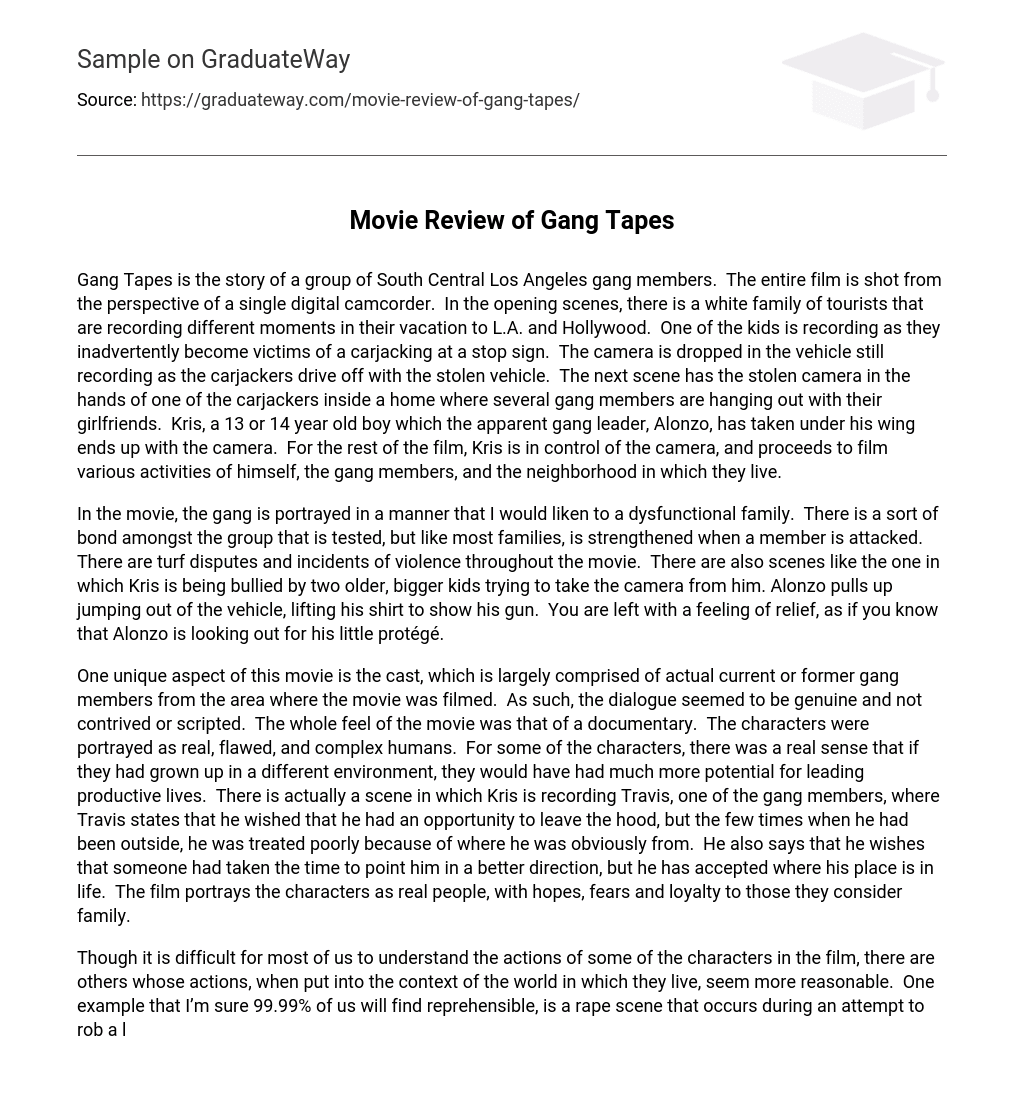Gang Tapes is the story of a group of South Central Los Angeles gang members. The entire film is shot from the perspective of a single digital camcorder. In the opening scenes, there is a white family of tourists that are recording different moments in their vacation to L.A. and Hollywood. One of the kids is recording as they inadvertently become victims of a carjacking at a stop sign. The camera is dropped in the vehicle still recording as the carjackers drive off with the stolen vehicle. The next scene has the stolen camera in the hands of one of the carjackers inside a home where several gang members are hanging out with their girlfriends. Kris, a 13 or 14 year old boy which the apparent gang leader, Alonzo, has taken under his wing ends up with the camera. For the rest of the film, Kris is in control of the camera, and proceeds to film various activities of himself, the gang members, and the neighborhood in which they live.
In the movie, the gang is portrayed in a manner that I would liken to a dysfunctional family. There is a sort of bond amongst the group that is tested, but like most families, is strengthened when a member is attacked. There are turf disputes and incidents of violence throughout the movie. There are also scenes like the one in which Kris is being bullied by two older, bigger kids trying to take the camera from him. Alonzo pulls up jumping out of the vehicle, lifting his shirt to show his gun. You are left with a feeling of relief, as if you know that Alonzo is looking out for his little protégé.
One unique aspect of this movie is the cast, which is largely comprised of actual current or former gang members from the area where the movie was filmed. As such, the dialogue seemed to be genuine and not contrived or scripted. The whole feel of the movie was that of a documentary. The characters were portrayed as real, flawed, and complex humans. For some of the characters, there was a real sense that if they had grown up in a different environment, they would have had much more potential for leading productive lives. There is actually a scene in which Kris is recording Travis, one of the gang members, where Travis states that he wished that he had an opportunity to leave the hood, but the few times when he had been outside, he was treated poorly because of where he was obviously from. He also says that he wishes that someone had taken the time to point him in a better direction, but he has accepted where his place is in life. The film portrays the characters as real people, with hopes, fears and loyalty to those they consider family.
Though it is difficult for most of us to understand the actions of some of the characters in the film, there are others whose actions, when put into the context of the world in which they live, seem more reasonable. One example that I’m sure 99.99% of us will find reprehensible, is a rape scene that occurs during an attempt to rob a local business man and his family after he gets home one evening. There are lines that even many of the hardened thugs won’t cross easily. Even though Alonzo appears to be a hardened gang-banger, he is repulsed at the actions of his fellow gang member, and proceeds to grill him over his actions. He apparently see’s their actions of holding the family at gunpoint as being in the realm of reasonable, but the act of sexually assaulting someone’s mother, wife, or sister as having crossed the line of acceptability.
This low level gang is involved in multiple crimes, from the carjacking in the opening scenes to the open drug use of the members of the gang throughout the movie. Later we see Alonzo, one of the main gang-bangers, cooking up some crack on the kitchen stove. Ironically, it is Alonzo’s pregnant girlfriend that makes our young cameraman, Kris, leave the house, saying that he doesn’t need to see what is going on or how to make the drugs. This made me feel a sense of “just because this has to be our life, doesn’t mean it needs to be his…” We later see members of the gang out on the street selling drugs. There is a retaliatory drive by shooting, as well as several assaults and beat downs. Within an hour of his release from lock-up, Cyril, an older short tempered gang member, proceeds to beat down a former rival gang member. In reflection this scene represented some symbolism regarding the reality that even once a member has left the lifestyle of gang violence behind, gang violence may still find him.
There are several deaths that occur in this film that are tragic. In a way, it shows that we all have redeeming qualities, and that our actions are not only influenced by the world around us, but are also influencing factors within that same world. Gang Tapes is a movie that humanizes and provides a glimpse into to the realities of life in a low level gang. It does so in a manner that does not glamourize the lives, but rather puts it into perspective.
References
Ripp, A. (Director). (2002). Gang Tapes [Motion picture]. U.S.: Lions Gate.





